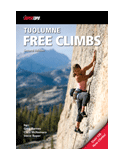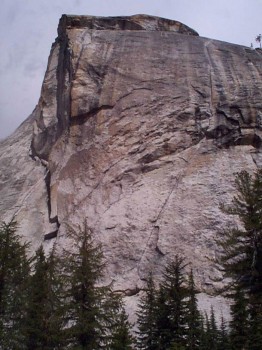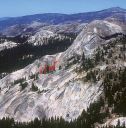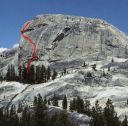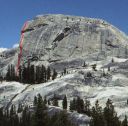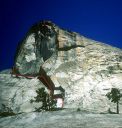West Crack, Daff Dome 5.9 |
||
Tuolumne Meadows, California USA | ||
| ||
|
Avg time to climb route: 2-4 hours
Approach time: 20 minutes Descent time: 30 minutes Number of pitches: 6 Height of route: 700' Overview
Looking at Daff Dome from the parking area, you would never imagine that the west face could be climbed at anything less than 5.12. Yet a splitter finger crack in the middle of the giant golden face goes at only 5.8. Except for a few face moves off the ground, which are protected by a bomber bolt, the entire route is 5.8. While the roof at the start of the second pitch is intimidating, hidden holds make it reasonable. Even the offwidth on Pitch 4 is climbed via great face holds to the right.
Photos
- View all 3 photos of West Crack as: Thumbnails | Slideshow
Climber Beta on West Crack
Which SuperTopo guidebooks include a topo for West Crack?
Find other routes like
West Crack
History
It’s hard to believe that this handsome chunk of granite had no name as late as 1963. Frank Sacherer and Wally Reed, in July of that year, climbed the classic West Crack, one of the earliest Tuolumne climbs. When Valley climbers asked where this gem was, Sacherer hesitated only a moment before replying: “dome across from Fairview.” Within weeks this had been shortened to Daff. The admirable Tuolumne ethic of never using aid perhaps originates from the climb of West Crack (Pratt and Reed, on Fairview in 1958, had used lots of aid, but this was in the Dark Ages and the cracks brimmed with dirt, meaning that jamming was out of the question). By 1963 Sacherer and Reed were superb free climbers and as they stood beneath the west face of Daff they spotted crystals and dikes and knobs and cracks everywhere. This was high-country granite, weathered far more than the smooth walls of the Valley. It seems safe to say that as they roped up they were thinking of a free ascent. Trouble was, about 20 feet above the ground the rock was, for a short distance, smooth and featureless, almost Valley-like. But it posed little problem, going at 5.9. Higher, the climbing proved thrilling and amazingly easy, and pitons could be driven anywhere for protection. Because Sacherer had a huge free-climbing agenda down in the Valley, he never again put up a first ascent in Tuolumne. One wonders what he would have done had he lived in the Meadows for a few months! – Steve Roper Strategy
Come prepared to wait in line or climb nearby routes. Large cams are needed to protect the fourth pitch or you can run it out. Beware of the possibility that the rope may drag cams into the crack on this pitch. If you have a #11 Hexcentric, bring it and use it at the bottom of the offwidth—not only is it great pro, it also keeps the rope running smoothly. With a 60m rope you can climb the route in four pitches with no difficulty.The crux of the route is the first 30 feet. Clip the bolt with a single locker and stand on thin polished edges, working up to a good crimp. A few easier moves gain the crack, which stays easy for the next 60 feet. For the roof on the second pitch, jam with the right hand and use bomber jugs up and left to work your way through the overhang. This section is easier if you are tall. West Crack is high up and often windy. Since it gets afternoon sun, strong parties often finish the day by running up it, while most people begin their climb as soon as the sun hits the wall. In the hot days of mid-summer it is an excellent morning route. Retreat
Retreat with two ropes by leaving gear and/or using anchors on Blown Away, West Crack, and Witch of the West. Be careful on the rappel from the top of the first pitch—it just makes the anchors of Witch of the West.Approach
Drive 3.6 miles west of the Tuolumne Meadows Store or 3 miles east of Tenaya Lake. Park either at a tiny dirt pullout in trees just north of the creek or at a dirt pullout just south of the creek. If both of these are full, park on the other side of the road next to trees immediately opposite the small dirt pullout. All of these parking spots are relatively small and located at a sweeping turn of Highway 120 with a 45 m.p.h. speed limit—so take great care in parking and moving around the vehicles.Locate the trail which starts where the creek comes out under the highway. It heads up a tree-filled gully between ribs of low-angle granite toward the huge west face of Daff Dome. Follow the trail up for about 300 yards, then down a gentle slope and slowly up again below a 100-foot-tall overhung cliff (home of Cowabunga, a 5.12c roof flake). The trail then curves up and right around the cliff and brings you to the wall below West Crack. Hike up and right to the ledge that traverses left to West Crack and Cooke Book, and hike 50 feet right to get to Crescent Arch. Descent Descent
Rappel Route (best option)Use one 50m or 60m rope. From the top, walk to the east end of the dome and locate bolts with chains on top of a big block next to the only large tree. Rappel to an anchor in the middle of the face. Another rappel gets you to the ground. Meander down along the dome until you see a few good looking cracks (5.6-5.8 with bolts at the top) on the wall to your right. Next, follow the trail down the gully to the road then walk a few yards back to the car. Walk-off Wear climbing shoes. From the top, go south down exposed and polished 4th class slab. Use intelligent routefinding to avoid steep sections. Most climbers sit down and use hand, foot, and butt friction to descend one short, steep section of golden polish. Work back right (west) to easier slabs and the base of the climbs. Do not attempt the walk-off if the rock is wet. Everything You Need to Know About
Tuolumne Meadows
Search the internet for beta on
West Crack
Other guidebooks that include info on West Crack
|
Other Routes on Daff Dome
|



